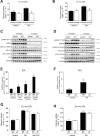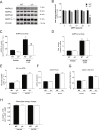Compound- and fiber type-selective requirement of AMPKγ3 for insulin-independent glucose uptake in skeletal muscle
- PMID: 33798773
- PMCID: PMC8381060
- DOI: 10.1016/j.molmet.2021.101228
Compound- and fiber type-selective requirement of AMPKγ3 for insulin-independent glucose uptake in skeletal muscle
Abstract
Objective: The metabolic master-switch AMP-activated protein kinase (AMPK) mediates insulin-independent glucose uptake in muscle and regulates the metabolic activity of brown and beige adipose tissue (BAT). The regulatory AMPKγ3 isoform is uniquely expressed in skeletal muscle and potentially in BAT. Herein, we investigated the role that AMPKγ3 plays in mediating skeletal muscle glucose uptake and whole-body glucose clearance in response to small-molecule activators that act on AMPK via distinct mechanisms. We also assessed whether γ3 plays a role in adipose thermogenesis and browning.
Methods: Global AMPKγ3 knockout (KO) mice were generated. A systematic whole-body, tissue, and molecular phenotyping linked to glucose homeostasis was performed in γ3 KO and wild-type (WT) mice. Glucose uptake in glycolytic and oxidative skeletal muscle ex vivo as well as blood glucose clearance in response to small molecule AMPK activators that target the nucleotide-binding domain of the γ subunit (AICAR) and allosteric drug and metabolite (ADaM) site located at the interface of the α and β subunit (991, MK-8722) were assessed. Oxygen consumption, thermography, and molecular phenotyping with a β3-adrenergic receptor agonist (CL-316,243) treatment were performed to assess BAT thermogenesis, characteristics, and function.
Results: Genetic ablation of γ3 did not affect body weight, body composition, physical activity, and parameters associated with glucose homeostasis under chow or high-fat diet. γ3 deficiency had no effect on fiber-type composition, mitochondrial content and components, or insulin-stimulated glucose uptake in skeletal muscle. Glycolytic muscles in γ3 KO mice showed a partial loss of AMPKα2 activity, which was associated with reduced levels of AMPKα2 and β2 subunit isoforms. Notably, γ3 deficiency resulted in a selective loss of AICAR-, but not MK-8722-induced blood glucose-lowering in vivo and glucose uptake specifically in glycolytic muscle ex vivo. We detected γ3 in BAT and found that it preferentially interacts with α2 and β2. We observed no differences in oxygen consumption, thermogenesis, morphology of BAT and inguinal white adipose tissue (iWAT), or markers of BAT activity between WT and γ3 KO mice.
Conclusions: These results demonstrate that γ3 plays a key role in mediating AICAR- but not ADaM site binding drug-stimulated blood glucose clearance and glucose uptake specifically in glycolytic skeletal muscle. We also showed that γ3 is dispensable for β3-adrenergic receptor agonist-induced thermogenesis and browning of iWAT.
Keywords: 5-aminoimidazole-4-carboxamide riboside; AMP-activated protein kinase; Beige adipose tissue; Brown adipose tissue; MK-8722; TBC1D1.
Copyright © 2021 The Authors. Published by Elsevier GmbH.. All rights reserved.
Figures











Similar articles
-
Direct small molecule ADaM-site AMPK activators reveal an AMPKγ3-independent mechanism for blood glucose lowering.Mol Metab. 2021 Sep;51:101259. doi: 10.1016/j.molmet.2021.101259. Epub 2021 May 23. Mol Metab. 2021. PMID: 34033941 Free PMC article.
-
Benzimidazole derivative small-molecule 991 enhances AMPK activity and glucose uptake induced by AICAR or contraction in skeletal muscle.Am J Physiol Endocrinol Metab. 2016 Oct 1;311(4):E706-E719. doi: 10.1152/ajpendo.00237.2016. Epub 2016 Aug 30. Am J Physiol Endocrinol Metab. 2016. PMID: 27577855 Free PMC article.
-
Knockout of the alpha2 but not alpha1 5'-AMP-activated protein kinase isoform abolishes 5-aminoimidazole-4-carboxamide-1-beta-4-ribofuranosidebut not contraction-induced glucose uptake in skeletal muscle.J Biol Chem. 2004 Jan 9;279(2):1070-9. doi: 10.1074/jbc.M306205200. Epub 2003 Oct 21. J Biol Chem. 2004. PMID: 14573616
-
Emerging Role of AMPK in Brown and Beige Adipose Tissue (BAT): Implications for Obesity, Insulin Resistance, and Type 2 Diabetes.Curr Diab Rep. 2018 Aug 17;18(10):80. doi: 10.1007/s11892-018-1049-6. Curr Diab Rep. 2018. PMID: 30120579 Review.
-
Beyond AICA riboside: in search of new specific AMP-activated protein kinase activators.IUBMB Life. 2009 Jan;61(1):18-26. doi: 10.1002/iub.135. IUBMB Life. 2009. PMID: 18798311 Free PMC article. Review.
Cited by
-
Natural (dihydro)phenanthrene plant compounds are direct activators of AMPK through its allosteric drug and metabolite-binding site.J Biol Chem. 2022 May;298(5):101852. doi: 10.1016/j.jbc.2022.101852. Epub 2022 Mar 21. J Biol Chem. 2022. PMID: 35331736 Free PMC article.
-
Direct small molecule ADaM-site AMPK activators reveal an AMPKγ3-independent mechanism for blood glucose lowering.Mol Metab. 2021 Sep;51:101259. doi: 10.1016/j.molmet.2021.101259. Epub 2021 May 23. Mol Metab. 2021. PMID: 34033941 Free PMC article.
-
Protocol for muscle fiber type and cross-sectional area analysis in cryosections of whole lower mouse hindlimbs.STAR Protoc. 2024 Dec 20;5(4):103424. doi: 10.1016/j.xpro.2024.103424. Epub 2024 Nov 1. STAR Protoc. 2024. PMID: 39487985 Free PMC article.
-
Structure-function analysis of the AMPK activator SC4 and identification of a potent pan AMPK activator.Biochem J. 2022 Jun 17;479(11):1181-1204. doi: 10.1042/BCJ20220067. Biochem J. 2022. PMID: 35552369 Free PMC article.
-
Fine-tuning AMPK in physiology and disease using point-mutant mouse models.Dis Model Mech. 2024 Aug 1;17(8):dmm050798. doi: 10.1242/dmm.050798. Epub 2024 Aug 13. Dis Model Mech. 2024. PMID: 39136185 Free PMC article. Review.
References
-
- Hawley S.A., Davison M., Woods A., Davies S.P., Beri R.K., Carling D. Characterization of the AMP-activated protein kinase kinase from rat liver and identification of threonine 172 as the major site at which it phosphorylates AMP-activated protein kinase. Journal of Biological Chemistry. 1996;271(44):27879–27887. - PubMed
Publication types
MeSH terms
Substances
Grants and funding
LinkOut - more resources
Full Text Sources
Other Literature Sources
Medical
Molecular Biology Databases
Research Materials

